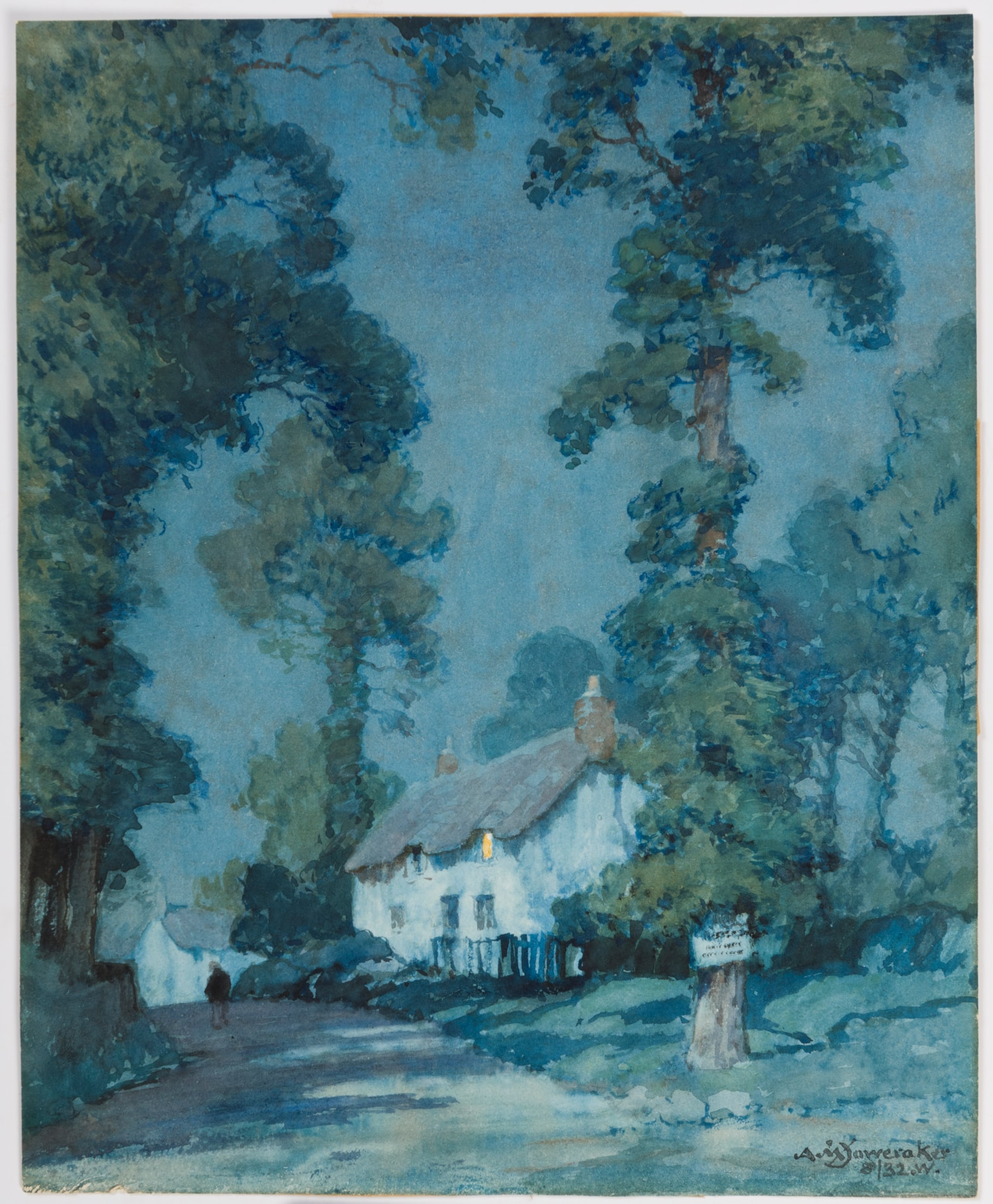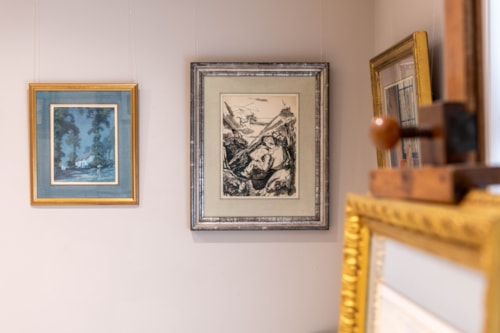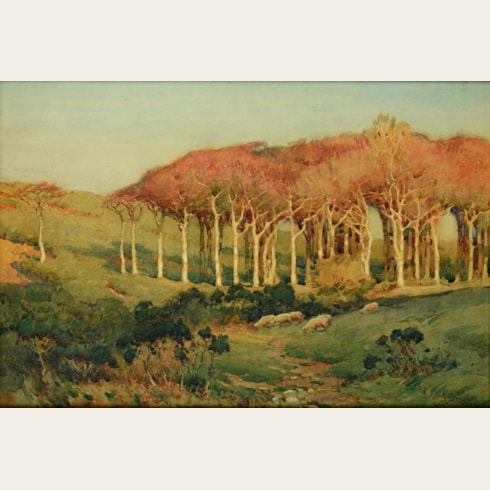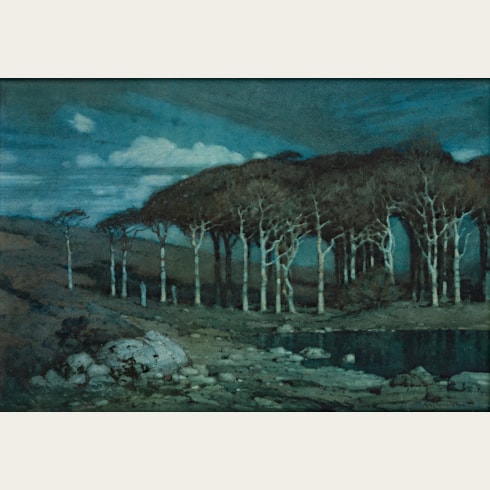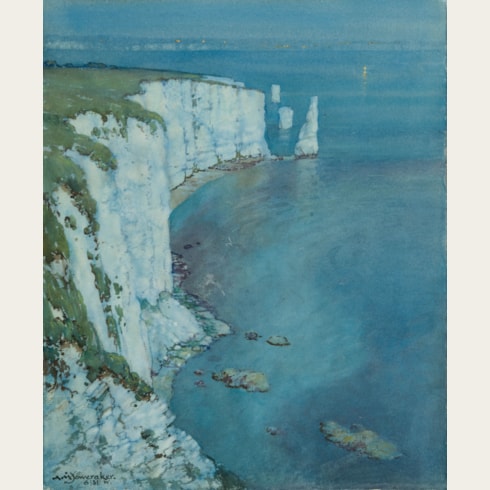Albert Moulton FOWERAKER
(Exeter 1873 - Swanage 1942)
Moonlight, Studland, Dorset
Sold
Watercolour and gouache.
Signed and dated AM Foweraker / 8/32.W. at the lower right.
Titled Moonlight: Studland in pencil on the verso.
Further inscribed Mrs. Turnberry(?) / 13 Nordham(?) Rd in pencil on the verso.
272 x 222 mm. (10 3/4 x 8 3/4 in.)
Signed and dated AM Foweraker / 8/32.W. at the lower right.
Titled Moonlight: Studland in pencil on the verso.
Further inscribed Mrs. Turnberry(?) / 13 Nordham(?) Rd in pencil on the verso.
272 x 222 mm. (10 3/4 x 8 3/4 in.)
As one modern scholar has noted, ‘Collectors would, without hesitation, describe Albert Moulton Foweraker...as primarily a watercolourist, and his twilight depictions of Spanish and English towns and villages are highly regarded...He developed a special talent for twilight scenes...These mood pieces must have tapped into the same market as the moonrises of his oil painting colleagues and clearly proved popular, as Foweraker concentrated on such twilight scenes to a significant degree.’
The small coastal village of Studland is situated on the peninsula known as the Isle of Purbeck in Dorset, north of the seaside resort town of Swanage. In his Highways and Byways of Dorset, published in 1906, the prominent surgeon Sir Frederick Treves described the village: ‘A very pleasant path across Ballard Down leads from Swanage to the beautiful village of Studland. This quiet little place lies on a flat where the chalk cliffs end and the sand dunes of the Poole inlet commence. It is a medley of country lanes, lost among trees, with a few thatch-roofed cottages dotted about in a wild garden of brambles, ferns, and gorse. There is nothing methodical or regular about Studland. There is no definite hamlet, no village street, no centre, no beginning, and no end. It is merely a casual, unarranged sample of rural Dorset brought, in all its luxuriant greenness, to the very water’s edge. In the maze of this shady oasis are, besides cottages, an exquisite Norman church, orchards and gardens, and cows in fields. There is no “sea front” to Studland, no pretence to a quay…Studland indeed declines to be maritime. It turns its face from the sea to bury it among its myrtles and fuschia bushes.’
The small coastal village of Studland is situated on the peninsula known as the Isle of Purbeck in Dorset, north of the seaside resort town of Swanage. In his Highways and Byways of Dorset, published in 1906, the prominent surgeon Sir Frederick Treves described the village: ‘A very pleasant path across Ballard Down leads from Swanage to the beautiful village of Studland. This quiet little place lies on a flat where the chalk cliffs end and the sand dunes of the Poole inlet commence. It is a medley of country lanes, lost among trees, with a few thatch-roofed cottages dotted about in a wild garden of brambles, ferns, and gorse. There is nothing methodical or regular about Studland. There is no definite hamlet, no village street, no centre, no beginning, and no end. It is merely a casual, unarranged sample of rural Dorset brought, in all its luxuriant greenness, to the very water’s edge. In the maze of this shady oasis are, besides cottages, an exquisite Norman church, orchards and gardens, and cows in fields. There is no “sea front” to Studland, no pretence to a quay…Studland indeed declines to be maritime. It turns its face from the sea to bury it among its myrtles and fuschia bushes.’
A painter and watercolourist, Albert Moulton Foweraker earned a degree in applied science in 1893 and worked as an engineer and journalist in his native Exeter before taking up art as a full-time profession in 1898. In 1902 he was admitted to the Royal Society of British Artists, and the same year settled in the village of Lelant, near Carbis Bay in western Cornwall. He produced a number of views of the Cornish landscape and coastline and taught watercolour painting at Algernon Talmadge’s Cornish School of Landscape and Sea Painting in St. Ives. Foweraker exhibited regularly in London – showing over fifty works at the Royal Society of British Artists between 1902 and 1912 – and in a number of provincial galleries. His exhibition pictures were mainly landscapes and views in Devon and Cornwall, as well as Dorset, where he settled in the 1920s. Foweraker also travelled to Spain, France and North Africa, and exhibited numerous paintings and watercolours of views in these locations. From around 1905 onwards he spent several winters in Andalucia in southern Spain, where he organized painting classes, holding regular sessions in Málaga in January and February, Córdoba in March and Granada in April. Foweraker also contributed illustrations to Leonard Williams’s Granada: Memories, Adventures, Studies and Impressions, published in 1906, and Charles Marriott’s A Spanish Holiday, published in 1908.
Foweraker’s landscape paintings and watercolours are characterized by a particular interest in light effects, especially moonlight, and many of his works are dominated by an intense blue tonality. As one modern scholar has noted, ‘Collectors would, without hesitation, describe Albert Moulton Foweraker...as primarily a watercolourist, and his twilight depictions of Spanish and English towns and villages are highly regarded...For watercolour subjects, Foweraker unsurprisingly painted a number of semi-rural scenes in the locality of his home in Carbis Bay, and in nearby Lelant, but he was also fond of exploring the coastline, capturing reflections in pools in the sand underneath craggy cliffs. However, he developed a special talent for twilight scenes...These mood pieces must have tapped into the same market as the moonrises of his oil painting colleagues and clearly proved popular, as Foweraker concentrated on such twilight scenes to a significant degree.’
Foweraker’s landscape paintings and watercolours are characterized by a particular interest in light effects, especially moonlight, and many of his works are dominated by an intense blue tonality. As one modern scholar has noted, ‘Collectors would, without hesitation, describe Albert Moulton Foweraker...as primarily a watercolourist, and his twilight depictions of Spanish and English towns and villages are highly regarded...For watercolour subjects, Foweraker unsurprisingly painted a number of semi-rural scenes in the locality of his home in Carbis Bay, and in nearby Lelant, but he was also fond of exploring the coastline, capturing reflections in pools in the sand underneath craggy cliffs. However, he developed a special talent for twilight scenes...These mood pieces must have tapped into the same market as the moonrises of his oil painting colleagues and clearly proved popular, as Foweraker concentrated on such twilight scenes to a significant degree.’

